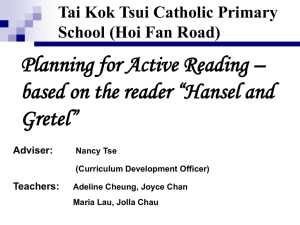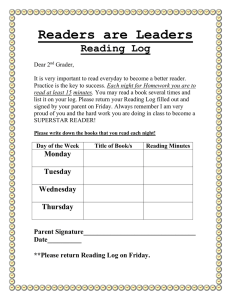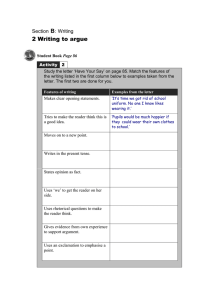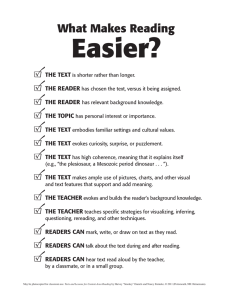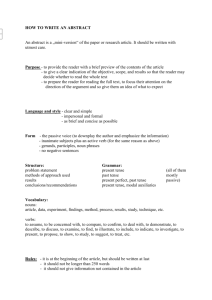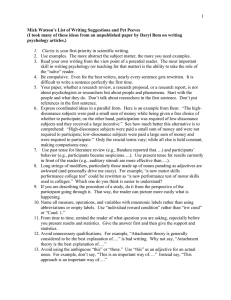APA 1 - SEAS
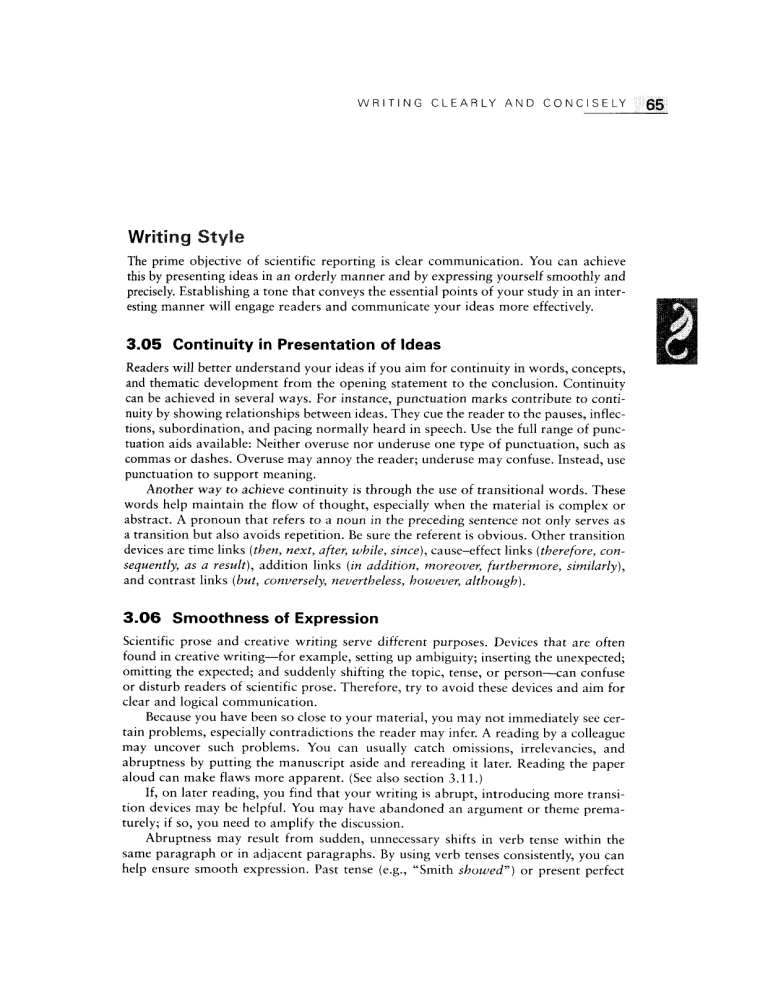
W R I T I N G C L E A R L Y A N D C O N C I S E L Y
Writing Style
The prime objective of scientific reporting is clear communication. You can achieve this by presenting ideas in an orderly manner and by expressing yourself smoothly and precisely. Establishing a tone that conveys the essential points of your study in an interesting manner will engage readers and communicate your ideas more effectively.
3.05 Continuity in Presentation of Ideas
Readers will better understand your ideas if you aim for continuity in words, concepts, and thematic development from the opening statement to the conclusion. Continuity can be achieved in several ways. For instance, punctuation marks contribute to continuity by showing relationships between ideas. They cue the reader to the pauses, inflections, subordination, and pacing normally heard in speech. Use the full range of punctuation aids available: Neither overuse nor underuse one type of punctuation, such as commas or dashes. Overuse may annoy the reader; underuse may confuse. Instead, use punctuation to support meaning.
Another way to achieve continuity is through the use of transitional words. These words help maintain the flow of thought, especially when the material is complex or abstract. A pronoun that refers to a noun in the preceding sentence not only serves as a transition but also avoids repetition. Be sure the referent is obvious. Other transition devices are time links (then, next, after, while, since), cause-effect links (therefore, con- sequently, as a result), addition links (in addition, moreover, furthermore, similarly), and contrast links (but, conversely, nevertheless, however, although).
3 . 0 6 Smoothness of Expression
Scientific prose and creative writing serve different purposes. Devices that are often found in creative writing—for example, setting up ambiguity; inserting the unexpected; omitting the expected; and suddenly shifting the topic, tense, or person—can confuse or disturb readers of scientific prose. Therefore, try to avoid these devices and aim for clear and logical communication.
Because you have been so close to your material, you may not immediately see certain problems, especially contradictions the reader may infer. A reading by a colleague may uncover such problems. You can usually catch omissions, irrelevancies, and abruptness by putting the manuscript aside and rereading it later. Reading the paper aloud can make flaws more apparent. (See also section 3.11.)
If, on later reading, you find that your writing is abrupt, introducing more transition devices may be helpful. You may have abandoned an argument or theme prematurely; if so, you need to amplify the discussion.
Abruptness may result from sudden, unnecessary shifts in verb tense within the same paragraph or in adjacent paragraphs. By using verb tenses consistently, you can help ensure smooth expression. Past tense (e.g., "Smith showed") or present perfect
W R I T I N G S T Y L E tense (e.g., "researchers have shown'''') is appropriate for the literature review and the description of the procedure if the discussion is of past events. Stay within the chosen tense. Use past tense (e.g., "anxiety decreased significantly") to describe the results.
Use the present tense (e.g., "the results of Experiment 2 indicate") to discuss implications of the results and to present the conclusions. By reporting conclusions in the present tense, you allow readers to join you in deliberating the matter at hand. (See section
3.19 for details on the use of verb tense.)
Noun strings, meaning several nouns used one after another to modify a final noun, create another form of abruptness. The reader is sometimes forced to stop to determine how the words relate to one another. Skillful hyphenation can clarify the relationships between words, but often the best approach is to untangle the string. For example, consider the following string: commonly used investigative expanded issue control question technique
This is dense prose to the reader knowledgeable about studies on lie detection— and gibberish to a reader unfamiliar with such studies. Possible ways to untangle the string are as follows:
• a control-question technique that is commonly used to expand issues in investigations
• an expanded-issue control-question technique that is commonly used in investigations
• a common technique of using control questions to investigate expanded issues
• a common investigative technique of using expanded issues in control questions
One approach to untangling noun strings is to move the last word to the beginning of the string and fill in with verbs and prepositions. For example, early childhood thought disorder misdiagnosis might be rearranged to read misdiagnosis of thought disorders in early childhood.
Many writers strive to achieve smooth expression by using synonyms or nearsynonyms to avoid repeating a term. The intention is commendable, but by using synonyms you may unintentionally suggest a subtle difference. Therefore, choose synonyms with care. The discreet use of pronouns can often relieve the monotonous repetition of a term without introducing ambiguity.
3 . 0 7 Tone
Although scientific writing differs in form from literary writing, it need not lack style or be dull. In describing your research, present the ideas and findings directly but aim for an interesting and compelling style and a tone that reflects your involvement with the problem.
Scientific writing often contrasts the positions of different researchers. Differences should be presented in a professional, noncombative manner. For example, "Fong and
Nisbett did not address . . ." is acceptable, whereas "Fong and Nisbett completely overlooked . . . " is not.
W R I T I N G C L E A R L Y A N D C O N C I S E L Y
One effective way to achieve the right tone is to imagine a specific reader you are intending to reach and to write in a way that will educate and persuade that individual.
Envisioning a person familiar to you may make this technique more effective. You may wish to write, for example, to a researcher in a related field who is trying to keep abreast of the literature but is not familiar with jargon or insider perspectives. What would facilitate his or her understanding of and appreciation for the importance of your work?
3 . 0 8 Economy of Expression
Say only what needs to be said. The author who is frugal with words not only writes a more readable manuscript but also increases the chances that the manuscript will be accepted for publication. The number of printed pages a journal can publish is limited, and editors therefore often request that authors shorten submitted papers. You can tighten long papers by eliminating redundancy, wordiness, jargon, evasiveness, overuse of the passive voice, circumlocution, and clumsy prose. Weed out overly detailed descriptions of apparatus, participants, or procedures (beyond those called for in the reporting standards; see Chapter 2); elaborations of the obvious; and irrelevant observations or asides. Materials such as these may be placed, when appropriate, in an online supplemental archive (see sections 2.13 and 8.03 for further details).
Short words and short sentences are easier to comprehend than are long ones. A long technical term, however, may be more precise than several short words, and technical terms are inseparable from scientific reporting. Yet the technical terminology in a paper should be readily understood by individuals throughout each discipline. An article that depends on terminology familiar to only a few specialists does not sufficiently contribute to the literature.
Wordiness.
Wordiness can also impede the ready grasp of ideas. Change based on the fact that to because, at the present time to now, and for the purpose of to simply for or to. Use this study instead of the present study when the context is clear. Change there were several students who completed to several students completed.
Unconstrained wordiness lapses into embellishment and flowery writing, which are clearly inappropriate in scientific style.
Redundancy.
Writers often use redundant language in an effort to be emphatic. Use no more words than are necessary to convey your meaning.
In the following examples, the italicized words are redundant and should be omitted: they were both alike one and the same a total of
68
participants in close proximity four different groups saw completely unanimous instructions, which were exactly just exactly the same as those used very dose to significance absolutely essential period of time has been previously found summarize briefly small in size the reason is because
W R I T I N G S T Y L E
Unit length.
Although writing only in short, simple sentences produces choppy and boring prose, writing exclusively in long, involved sentences results in difficult, sometimes incomprehensible material. Varied sentence length helps readers maintain interest and comprehension. When involved concepts require long sentences, the components should proceed logically. Direct, declarative sentences with simple, common words are usually best.
Similar cautions apply to paragraph length. Single-sentence paragraphs are abrupt.
Paragraphs that are too long are likely to lose the reader's attention. A new paragraph provides a pause for the reader—a chance to assimilate one step in the conceptual development before beginning another. If a paragraph runs longer than one doublespaced manuscript page, you may lose your readers. Look for a logical place to break a long paragraph, or reorganize the material.
3 . 0 9 Precision and Clarity
Word choice.
Make certain that every word means exactly what you intend it to mean.
In informal style, for example, feel broadly substitutes for think or believe, but in scientific style such latitude is not acceptable. A similar example is that like is often used when such as is meant:
Correct:
Articles by psychologists such as Skinner and Watson. . . .
Correct:
Like Watson, Skinner believed. . . .
Incorrect:
Articles by psychologists like Skinner and Watson. . . .
Colloquial expressions.
Avoid colloquial expressions (e.g., write up for report), which diffuse meaning. Approximations of quantity (e.g., quite a large part, practically all, or very few) are interpreted differently by different readers or in different contexts.
Approximations weaken statements, especially those describing empirical observations.
Jargon.
Jargon is the continuous use of a technical vocabulary, even in places where that vocabulary is not relevant. Jargon is also the substitution
of
a euphemistic phrase for a familiar term (e.g., monetarily felt scarcity for poverty), and you should scrupulously avoid using such jargon. Federal bureaucratic jargon has had the greatest publicity, but scientific jargon also grates on the reader, encumbers the communication
of information, and wastes space.
Pronouns.
Pronouns confuse readers unless the referent for each pronoun is obvious; readers should not have to search previous text to determine the meaning of the term.
Pronouns such as this, that, these, and those can be troublesome when they refer to something or someone in a previous sentence. Eliminate ambiguity by writing, for example, this test, that trial, these participants, and those reports (see also section 3.20).
Comparisons.
Ambiguous or illogical comparisons result from omission
of key
verbs or from nonparallel structure. Consider, for example, "Ten-year-olds were more likely to play with age peers than 8-year-olds." Does this sentence mean that 10-year-olds were more likely than 8-year-olds to play with age peers? Or does it mean that 10-
W R I T I N G C L E A R L Y A N D C O N C I S E L Y year-olds were more likely to play with age peers and less likely to play with 8-yearolds? An illogical comparison occurs when parallelism is overlooked for the sake of brevity, as in "Her salary was lower than a convenience store clerk." Thoughtful attention to good sentence structure and word choice reduces the chance of this kind of ambiguity.
Attribution.
Inappropriately or illogically attributing action in an effort to be objective can be misleading. Examples of undesirable attribution include use of the third person, anthropomorphism, and use of the editorial we.
Third person.
To avoid ambiguity, use a personal pronoun rather than the third person when describing steps taken in your experiment.
Correct:
We reviewed the literature.
Incorrect:
The authors reviewed the literature.
Anthropomorphism.
Do not attribute human characteristics to animals or to inanimate sources.
Correct:
Pairs of rats (cage mates) w e r e allowed to forage together.
Incorrect:
Rat couples (cage mates) were allowed to forage together.
Correct:
The staff for the community program was persuaded to allow five of the observers to become tutors.
Incorrect:
The community program was persuaded to allow five of the observers to become tutors.
An experiment cannot attempt to demonstrate, control unwanted variables, or interpret findings, nor can tables or figures compare (all of these can, however, show or indicate). Use a pronoun or an appropriate noun as the subject of these verbs. J or we (meaning the author or authors) can replace the experiment.
Editorial we.
For clarity, restrict your use of we to refer only to yourself and your coauthors (use I if you are the sole author of the paper). Broader uses of we may leave your readers wondering to whom you are referring; instead, substitute an appropriate noun or clarify your usage:
Correct:
Researchers usually classify birdsong on the basis of frequency and temporal structure of the elements.
Incorrect:
W e usually classify birdsong on the basis of frequency and temporal structure of the elements.
R E D U C I N G B I A S IN L A N G U A G E
Some alternatives to we to consider are people, humans, researchers, psychologists, nurses, and so on. We is an appropriate and useful referent:
Correct:
As behaviorists, w e tend to dispute . . .
Incorrect:
We tend to dispute . . .
3 . 1 0 Linguistic Devices
Devices that attract attention to words, sounds, or other embellishments instead of to ideas are inappropriate in scientific writing. Avoid heavy alliteration, rhyming, poetic expressions, and cliches. Use metaphors sparingly; although they can help simplify complicated ideas, metaphors can be distracting. Avoid mixed metaphors (e.g., a the- ory representing one branch of a growing body of evidence) and words with surplus or unintended meaning (e.g., cop for police officer), which may distract if not actually mislead the reader. Use figurative expressions with restraint and colorful expressions with care; these expressions can sound strained or forced.
3 . 1 1 Strategies to Improve Writing Style
Authors use various strategies in putting their thoughts on paper. The fit between author and strategy is more important than the particular strategy used. Three approaches to achieving professional and effective communication are (a) writing from an outline; (b) putting aside the first draft, then rereading it later; and (c) asking a colleague to review and critique the draft for you.
Writing from an outline helps preserve the logic of the research itself. An outline identifies main ideas, defines subordinate ideas, helps you discipline your writing and avoid tangential excursions, and helps you notice omissions. In an outline, you can also identify the subheadings that will be used in the article itself.
Rereading your own copy after setting it aside for a few days permits a fresh approach. Reading the paper aloud enables you not only to see faults that you overlooked on the previous reading but also to hear them. When these problems are corrected, give a polished copy to a colleague—preferably a person who has published in a related field but who is not familiar with your own work—for a critical review. Even better, get critiques from two colleagues, and you will have a trial run of a journal's review process.
These strategies, particularly the latter, may require you to invest more time in a manuscript than you had anticipated. The results of these strategies, however, may be greater accuracy and thoroughness and clearer communication.
Reducing
Bias
in Language
Scientific writing must be free of implied or irrelevant evaluation of the group or groups being studied. As an organization, APA is committed both to science and to the fair treatment of individuals and groups, and this policy requires that authors who write for APA publications avoid perpetuating demeaning attitudes and biased
